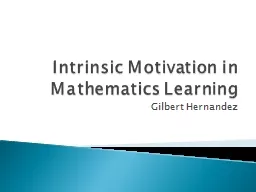

Gilbert Hernandez Motivational decline Motivation declines across childhood through adolescence the motivation to learn math exhibits the most severe decline Gottfried et al 2007 p317 ID: 596197
Download Presentation The PPT/PDF document "Intrinsic Motivation in Mathematics Lear..." is the property of its rightful owner. Permission is granted to download and print the materials on this web site for personal, non-commercial use only, and to display it on your personal computer provided you do not modify the materials and that you retain all copyright notices contained in the materials. By downloading content from our website, you accept the terms of this agreement.
Slide1
Intrinsic Motivation in Mathematics Learning
Gilbert HernandezSlide2
Motivational decline
“Motivation declines across childhood through adolescence… the motivation to learn math exhibits the most severe decline” (Gottfried et al., 2007, p.317).
Rationale of the studySlide3
Extrinsic motivation
T
he use of extrinsic motivators can be counterproductive by lowering the students’ intrinsic motivation (Gagne &
Deci
, 2005).
Description of the ProjectSlide4
Children who develop their intrinsic motivation are more likely to succeed on long term goals than those motivated by extrinsic factors (Middleton &
Midgley
, 2002).
What intrinsic motivators do student perceive as most important to learning mathematics in 4 specific 8
th
grade algebra 1 classes?
Research QuestionSlide5
1. Competency2. Autonomy
3. Relatedness
4. Fear
5. Self-efficacy
6. Effort
VariablesSlide6
Beginning of 3rd
Trimester
Survey
Likert
scale
Mixed method
Grade, gender
Free response
MethodSlide7
Two variables emerged with a mean score above 4 out of a possible 5.
Results
Competency
Autonomy
Relatedness
Fear
Self-efficacy
Effort
4.22
3.20
4.24
3.96
3.90
3.73Slide8
Performance vs. motivatorRelatedness = 4.83
Competence = 4.17
other variables 2.8, 3.0, 3.0, 3.5
Results by Gender
Qualitative Results
Other FindingsSlide9
Mathematical Practices
1. Make sense of problems and persevere in solving them.
3. Construct viable arguments and critique the reasoning of others.
5. Use appropriate tools strategically.
Common Core ConnectionsSlide10
Create meaningful activities
Increase collaborative learning (equity)
Access
“Unmotivated
students can become willing participants if tasks are tailored to their interests, or if students are given the opportunity to fulfill social needs by working with their friends” (
Schoenfelder
, 2006, p.345).
Implications